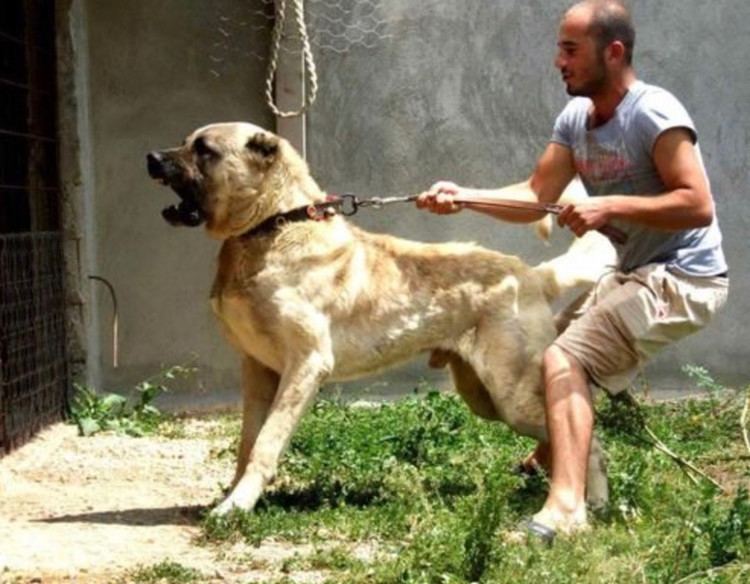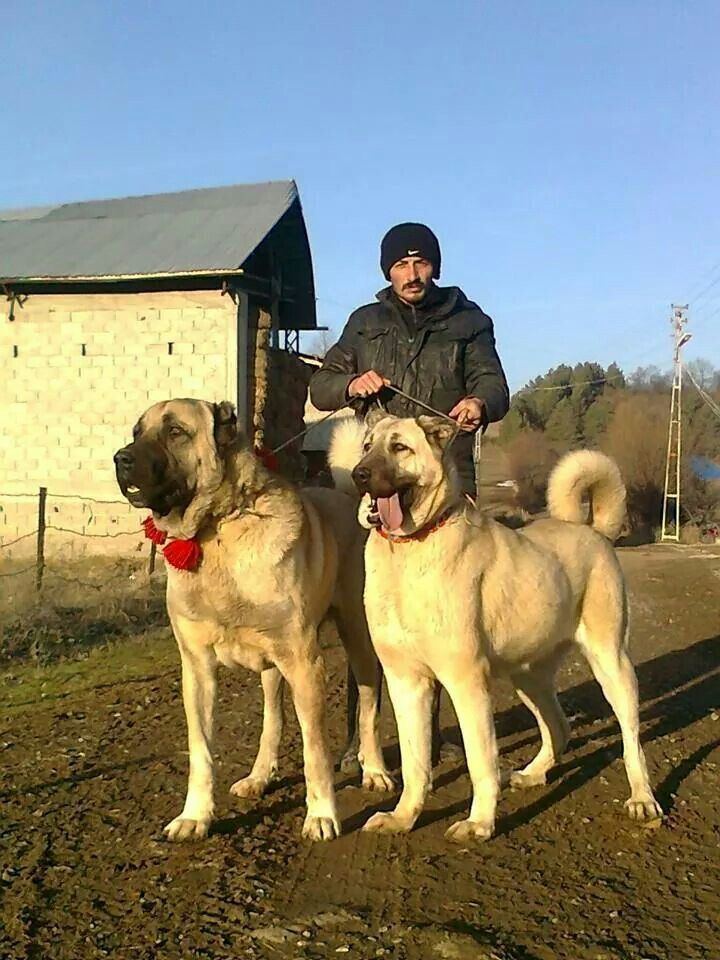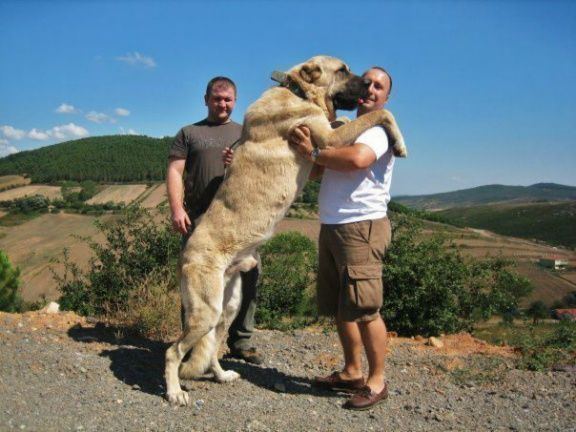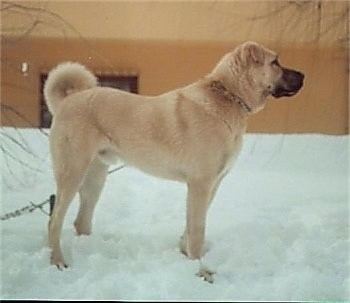Common nicknames Kangal KC (UK) Pastoral NZKC Utility Origin Turkey, Sivas Province | Patronage Turkey Pastoral standard Speed 50 km/h (Maximum) | |
 | ||
Other names Sivas Kangal, Turkish Kangal Height Female: 72–77 cm, Male: 77–86 cm Weight Female: 41–54 kg, Male: 50–66 kg Temperament Protective, Alert, Calm, Self-Controlled, Sensitive, Independent Colors Light Golden, Dun, Fawn Sable, Grey Similar Anatolian Shepherd, Caucasian Shepherd Dog, Akbash dog, Central Asian Shepherd, Dogo Argentino | ||
Turkish kangal dogs anatolian shepherds six thousand years of livestock guarding perfected
The Kangal (pronounced, khan-ghahl) is a breed of large livestock guardian dog originating from the Sivas province of Turkey. The breed is of an early Mastiff type with a solid, pale tan or sabled coat, and a black mask. According to official Kangal organisations in Turkey, including the Cynology Federation of Turkey (Köpek Irkları ve Kinoloji Federasyonu, KIF) and the Ankara Kangal Association (Ankara Kangal Derneği, ANKADER), Kangals may also be brindle or feature a recessive black tan pattern; with or without a black mask; and/or with white markings.
Contents
- Turkish kangal dogs anatolian shepherds six thousand years of livestock guarding perfected
- The kangal dog
- Origins
- Appearance
- Temperament
- Protective behavior
- KangalAnatolian Shepherd
- The Kangal internationally
- References
While the Kangal is often referred to as a sheep dog, it is not a herding dog, but rather a flock guardian that lives with the flock of sheep to actively fend off predators of all sizes. Typically used as protection against wolves, bears, and jackals in its native Turkey, the breed has been exported to African countries like Namibia and Kenya in more recent years due to its intimidating size and capabilities as an effective guardian, where it successfully protects local herds from lions, cheetahs, and similar indigenous big cats, which has had the benefit of not only protecting livestock, but ensuring the continuity of endangered predators due to reduced cullings by local farmers.

The Sivas Kangal Dog's protectiveness, loyalty, and gentleness with small children and animals has led to its growing popularity as a guardian for families as well, as it regards people as its "flock" and guards them with extreme devotion.

While similar in appearance, the Kangal is a separate breed from the Anatolian Shepherd.
The kangal dog
Origins

The breed's name derives from the contemporary Central Anatolian town of Kangal in Turkey's Sivas Province, and is believed to be from the same root as the Turkic tribe known as the "Kankalis".

Indeed, the toponym Kangal and the shepherd dog of the same name appear to have their origins in the Turkic people of Eurasia, specifically the Kankalis branch of the Oghuz Turks. This ethnonym of Kankalis —and its variants, Kangars, Kengers, Kanglys, Kanglis, and Kangils— which refers to the various Turkic Tatar tribes leaving Turkestan and settling in Anatolia in the latter half of the 9th century CE, ultimately came to be associated with the eponymous Kang territory outlined in Byzantine Emperor Konstantinos Porphyrogennetos' influential domestic and foreign policy manual De Administrando Imperio. These settlers built the commune of Kangal in the area where it is located today. The toponym derives directly from the ethnonym, and evidence is available that tribes designated by such names still exist among Turkic populations.
The Kangal sheepdog is thus regarded as a breed indigenous to Turkestan that was introduced to Anatolia by these Turkic migrants.
Alternative hypotheses for the origin of the Kangal dog are contested by breed experts and historians of the Near East. Suggestions that the Kangal dog is of Babylonian or Assyrian origin are rejected through biological science. Likewise, the hypothesis that the breed originated in India but was disseminated in Constantinople (today's Istanbul) from a single breeding pair brought from the Indian subcontinent do not appear to be supported by historical evidence.
Appearance
There are subtle variations given in the standards used by different countries when describing the height and weight. In the Kangal’s homeland of Turkey, the only measurements desired are quoted by KIF as a height at the withers of 65 to 78 cm (26 to 31 in) with a two cm tolerance either way. KIF does not differentiate between male and female statistics. Although other standards internationally are fairly consistent with each other, they are at odds with KIF as their guidelines are for a larger dog. In the UK, the Kennel Club interim standard states the height at shoulders should be males 74 to 81 cm (29 to 32 in) with females at 71 to 79 cm (28 to 31 in) without specifying any weight guidelines. The New Zealand Kennel Club quotes height for males as 76 to 81.5 cm (29.9 to 32.1 in) with a weight of 50 to 63 kg (110 to 139 lb) and a bitches height as 71 to 78.5 cm (28.0 to 30.9 in) weighing 41 to 59 kg (90 to 130 lb). In America, the only agency to recognise the breed is the UKC and its standard gives 30 to 32 in (76 to 81 cm) for males, weight 110 to 145 lb (50 to 66 kg) and 28 to 30 in (71 to 76 cm) for females with a weight of 90 to 120 lb (41 to 54 kg).
The Kangal Dog is not as heavy as some other Mastiff breeds, allowing it greater speed and agility than larger dogs. Kangal dogs can reach speeds of up to 50 km (30 miles) per hour. The under-layer provides insulation against both severe Anatolian winters and the fierce summer sun, while the outer-layer repels water and snow. This combination of coat allows it to regulate its core temperature more efficiently, while the coat is dense enough to repel rupture from wolf bites. Further differences between the KIF standard and those used internationally are found in the guidelines for coat and colour. The registered Kangal organizations in Turkey, Cynology Federation Of Turkey (KIF)—to an extent—and Ankara Kangal Derneği (ANKADER) do not regard coat colour as a breed defining feature. Brindle, recessive black tan pattern, white markings and a longer coat are regarded as Kangal and are not usually indicative of cross breeding, as the KIF standard as significant restrictions on accepted color and is more restrictive with respect to white markings than any of the other international standards, as white markings are only accepted on the chest and on the tip of the tail, whereas standards from other kennel clubs allow white markings on the feet and legs. Rather it is head structure and morphology that differentiate Kangal from other Çoban Köpegi. In contrast other kennel clubs describe coat and colour as perhaps the most visible traits that distinguish the Kangal from the Akbash and Anatolian. The coat must be short and dense, not long or feathery, and of a pale fawn or tan color with varying amounts of sable guard hairs. All Kangal Dogs have a black facial mask, and black or shaded ears. White at certain points (chest, chin, toes) may or may not be allowed, depending on the standard. Some heavily sabled Kangals also have darker legs and chests. Most importantly, the coat should not be broken, brindled, or spotted. Cropping of the ears is done for several reasons, including the cultural demonstration of ownership vice feral dog, for appearance and for protection, as long ears can be vulnerable in a physical confrontation with a predator. It is also believed that cropping improves the dog's hearing because sound can travel into ear easier. It should be noted the cropping of ears is illegal in the UK.
Temperament
The Kangal dog is calm, controlled, independent, powerful and protective. They may be aloof towards strangers, but a well-socialized Kangal Dog is friendly with visitors and especially children. They must never be shy or vicious. A well-trained Kangal is sensitive and alert to changing situations, responding to threats with judicious warnings and courageous action if necessary. They make good guardians of livestock and humans alike, but they may not be suitable for inexperienced dog owners, as the independent intelligence of the Kangal makes for a difficult pupil.
Protective behavior
A working Kangal on duty will station itself on a high vantage point overlooking its flock. On hot days, the dog will dig itself a hollow in the ground to keep cool. Novices learn by staying close to older dogs. The dogs will work in pairs or teams depending on the size of the flock, taking up positions around the sheep and changing their positions as needed. The intensity of their patrols around the sheep increases at nightfall.
When suspicious, a Kangal will stand with its tail and ears erect and give an alarm call, inciting the sheep to gather around it for protection. The Kangal’s first instinct is to place itself between the perceived threat and the sheep or master. Once the sheep are safely behind it, the Kangal confronts the intruder. When faced with a wolf, the Kangal sometimes is successful in intimidating the enemy, but it will resort to a physical confrontation if the predator stands its ground. Specialized wolf killers are known as "kurtçul kangal" in their homeland.
Kangal/Anatolian Shepherd
The UK Kennel Club announced it will recognise the Kangal Dog as a breed with effect from July 2013. It also stated that dogs currently registered as Anatolian Shepherd Dogs may be eligible (where appropriate) to be recorded as Turkish Kangal Dogs instead.
As of 1 January 2012, the Australian National Kennel Council no longer recognises the ANKC Kangal as being a separate breed from the ANKC Anatolian Shepherd.
The Kangal internationally
Britain’s first Kangal litter was produced in 1967 by Gazi of Bakirtollo village and his mate Sabahat of Hayıroğlu village. Dogs from this original line formed the foundation of the so-called "Seacop" stock.
In October 2012 The Kennel Club announced it will recognise the Kangal Dog as a breed and classify it within the Pastoral Group. This will allow the breed to be exhibited at KC licensed events in the UK from July 2013. In December 2012 an interim Breed standard for the breed will be issued. The interim standard was issued in January 2013.
In the US, the first purebred breeding programs for Kangal Dogs began in the early 1980s. The Kangal Dog is recognized by the United Kennel Club in the US, and by the national kennel clubs of South Africa and New Zealand. Many Kangal Dogs are being bred in Germany as well, mostly by immigrant workers. Some are registered as Anatolians, that being the only registration option open to them in Germany; most are unregistered.
On January 1, 2012, the Australian National Kennel Club discontinued its recognition of the ANKC Kangal Dog as a separate breed to the Anatolian Shepherd Dog.
In Namibia the dogs are being used to help protect livestock from cheetah attacks. Around 500 Kangals have been given to farmers in Namibia since 1994 by the Cheetah Conservation Fund (CCF) and the scheme has proved so successful that it has been extended to Kenya. During the past 14 years the number of cheetahs killed by farmers is calculated to have fallen from 19 per farmer annually to 2.4. Livestock losses have been cut significantly at more than 80% of the farms where the dogs have been adopted. The great majority of cheetahs that are still killed by farmers are killed after specific attacks on livestock. Previously, the cats were tracked and killed whenever they neared a farm.
